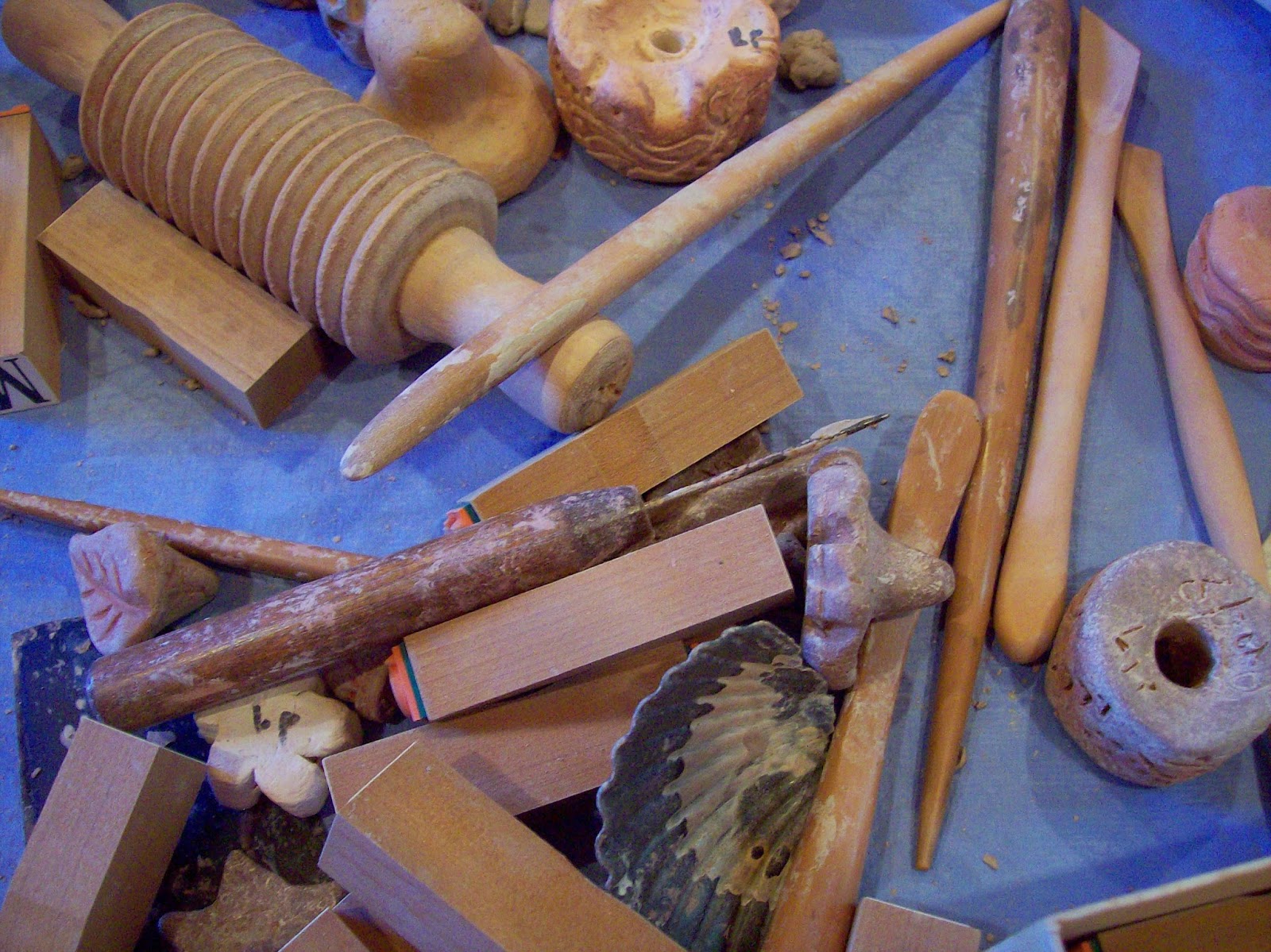How do you DO that? It's a question artists and craftspeople are often asked. There are as many ways of making things as there are folks making them. Here's a peek into my basic process with stoneware, porcelain and terracotta clays.
 |
| Clay Tools |
Most folks are familiar with poured ceramics - the process in which slip is poured into ceramic molds. When the slip hardens, the mold is removed, the piece cleaned, bisque fired, glazed and re-fired. This is done at a relatively low temperature compared to other ceramic work Folks are also usually somewhat familiar with wheel-thrown work, in which the potter forms a lump of clay into an object while 'spinning" it on a potter's wheel. Again, the work must be trimmed, dried, bisque-fired, glazed and final fired. Temperatures here can go very high and there are many different ways to fire that give varied results.
I am primarily a hand-builder - that means I work with clay bodies without a wheel - hand-forming from either lumps or rolled out slabs of clay. I create my own original designs and each piece has variations, even if I repeat a design. Only if I make a mold from one of my originals can each piece turn out pretty much the same.
 |
| Hand-Built Sun Face Tile 6"x6" -Betsy J. Parker |
 |
| Another Sun Face Tile - Same Design, Different Face Appears - Betsy. J. Parker |
Clay bodies are formulations of different clays and raw materials, each created with specific qualities and designed to fire in a particular temperature range.
 |
| Open Bag of Stoneware Clay |
There are many ways to decorate pottery - the most frequently used one being glazing. Glazes are not like paints - you can't mix yellow and blue and get green. They are chemicals, formulated to melt over the object and essentially create a glass-like layer, sealing and decorating at the same time. There's a lot going on technically, but let's get to the fun stuff - the MAKING of a piece.
 |
| Glazes and Raw Materials |
One starts, of course, with an idea. I generally know what I plan to make, but often the clay seems to have a mind of its own. I like to think of it as a dance I do with the clay. Sometimes I lead and sometimes I follow - pushing, pulling, stretching, shaping - to help the piece come into form. If it's a more complex form, multiple pieces of clay will be put together using slip to attach them, building it in a way similar to sewing a garment from many pieces.
 |
| Clay Cut and Waiting to be Formed |
|
|
|
 |
| Shape and Texture Begin |
 |
| Features Start to be Formed |
 |
| Face Ready to Dry on the Shelves |
Once the piece is shaped to my satisfaction, it's left to dry and later buffed or sanded.
 |
| Garden Bells Drying on the Workshop Shelves |
Most potters bisque fire pieces to a lower temperature to do away with impurities and make the pieces less fragile for glazing. I generally single-fire, which means I glaze pieces that are dry and brittle and easy to break or to cause to collapse from moisture in the glazes. It also means most of my work is brush-glazed, a time-consuming process.
 |
| Glazing in Progress |
I then fire them for the first and only firing to a higher temperature. It's a risky process, but one that I enjoy. Firing takes a number of hours depending on how full the kiln is and how hot I'm firing. Most of my firings take between 6 and 8 hours and the temperature is between 2200 and 2300 degrees fahrenheit. When the kiln cools, the magic appears. Clay is not an exact thing. Often there are glaze disappointments; sometimes pieces crack or break in the kiln. But always, there's enough excitement to keep me coming back.
 |
| Sun Face In the Kiln Ready to be Fired |
And that's how ya get there from here!
 |
| Terracotta Sun - Betsy J. Parker |















Fun to see your process Betsy! Thanks for sharing and allowing us to see how your creations come alive!
ReplyDelete